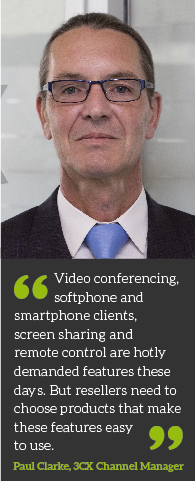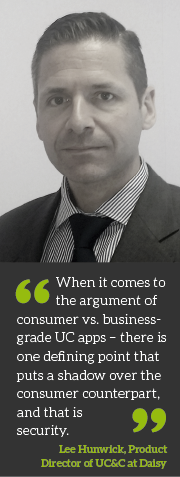
Recent research from Gartner revealed that UC is expected to see a global growth reaching around $40bn by 2019, as more businesses, regardless of shape, size and industry start to realise the substantial benefits, which can be seen from having an effective communications platform installed within their network. Whichever way you look at the UC market, it is a space which is too big to be ignored. So how have UC conversations developed in recent years and where does the mobility piece fit in?
 Paul Clarke, 3CX Channel Manager commented, “Mobility is not new to the UC argument; it is intrinsic to it, as far as customers are concerned. Responsible for running businesses, customers realise that empowering the mobile workforce is key to survival as a company. Eight out of ten companies say that remote working and mobility are critical to remain competitive, and UC tools are key to making mobility work, according to Dimension Data’s 2016 Connected Enterprise Report.”
Paul Clarke, 3CX Channel Manager commented, “Mobility is not new to the UC argument; it is intrinsic to it, as far as customers are concerned. Responsible for running businesses, customers realise that empowering the mobile workforce is key to survival as a company. Eight out of ten companies say that remote working and mobility are critical to remain competitive, and UC tools are key to making mobility work, according to Dimension Data’s 2016 Connected Enterprise Report.”
Martin Taylor, CMO of Content Guru, said “In business it’s no longer just about traditional customer contact channels such as voice and email - customers now take it for granted that they will be able to contact organisations via social media, SMS and IM web chat, and this also is reflected in the current UC market. These expectations apply equally to colleagues as they do to consumers, and there’s an assumption that workers will also be able to collaborate across multiple channels, whether they are at home, in the office or on the road. Using WebRTC video conferencing technology, for example, colleagues can hold face-to-face conversations wherever they are in the world through a simple browser interface.
Karl Alderton, Managing Director of Comms Supply, says end users aren’t necessarily aware of the benefits mobility features can bring. He said, “Mobility features are still quite new, with many end users not even aware there are such features. The term UC has obviously been around for many years but I believe many end users don’t know what it means or what is possible.
It is up to the Channel to educate partners on the possibilities so that they really understand the features and benefits available; therefore giving them an advantage when selling a UC solution.
I believe in 2017 we will see a massive uptake in mobility-type features as many businesses are allowing their staff to have more flexibility when it comes to where and when they work. Technology that allows you to transform your phone from a static desk phone to a phone that is with you wherever you are, will allow this flexibility to happen more and more.”
What’s Hot in UC?
 Features for most UC propositions are too many to count in 2016, in fact a large number of features may even go unused if businesses don’t need, or are unaware, of it. So what is selling out there right now?
Features for most UC propositions are too many to count in 2016, in fact a large number of features may even go unused if businesses don’t need, or are unaware, of it. So what is selling out there right now?
Lee Hunwick, Product Director of UC&C at Daisy commented, “Dual SIM technology is now becoming more prevalent, so the computing power in a smartphone is so high that the development of UC solutions on mobile devices will only continue to grow. As an example, Cisco is currently working with Apple to get access to the embedded technology on the devices and also to be able to use the native dialler on iPhones, rather than having to have an installed UC application.
This is great news for Apple, as it provides them with more credibility in the enterprise market, as they have always been more prominent in the consumer market. It will be interesting to see how that partnership pans out, with the high price point that those devices carry.”
Russell Lux, CEO of TelcoSwitch, says, “The portfolio of solutions now available via UC is rapidly growing and is only escalating further with the proliferation mobility. Service providers now have many lines of business including VoIP, residential VoIP, SIP trunking, hosting, mobility, data services and wholesale services. For organisations the breadth of this offering now provides a level of confidence, which hasn’t previously existed when sourcing UC services.”
Paul Clarke added, “Video conferencing, softphone and smartphone clients, screen sharing and remote control are hotly demanded features these days. But resellers need to choose products that make these features easy to use. If access to video is too complicated, workers won’t use it. And resellers should consider whether these features add a lot of cost or if they are included in a full UC package.”
Converting the SME
Unified Communications is no longer exclusively for those enterprises with big IT budgets, it’s more accessible than ever to them SMB too. Ron Cottaar, Marketing Director at Gigaset pro, says that the SME is where the Channel will find the biggest opportunity.
 Cottaar commented, “Adoption of Unified Communication is more prevalent with larger organisations and there is still a large untapped opportunity within the SME community. Part of the challenge is highlighting the UC benefits to smaller businesses and offering solutions that can provide a rapid and quantifiable return on investment. This should include better customer call handling through integration with applications as well as better access to non-voice channels such as IM, SMS and email. The wider consumer reality is that more people, and especially the younger generation, are keen to communicate over a wider range of channels than just voice. Businesses that fail to provide support for these methods and fail to unify how they process these disparate communication paths will be less efficient and potentially incur more cost in handling these conversations.
Cottaar commented, “Adoption of Unified Communication is more prevalent with larger organisations and there is still a large untapped opportunity within the SME community. Part of the challenge is highlighting the UC benefits to smaller businesses and offering solutions that can provide a rapid and quantifiable return on investment. This should include better customer call handling through integration with applications as well as better access to non-voice channels such as IM, SMS and email. The wider consumer reality is that more people, and especially the younger generation, are keen to communicate over a wider range of channels than just voice. Businesses that fail to provide support for these methods and fail to unify how they process these disparate communication paths will be less efficient and potentially incur more cost in handling these conversations.
For channel partners looking at UC, it is worth looking at the overall brand and commitment of equipment and software suppliers. The tick boxes on spec sheets are not the best guide as to the how a UC solution will actually work. A feature list does not tell you if a UC supplier will continue to develop products and support emerging technologies and the rapidly growing app market. There is also a case for choosing an end-to-end supplier over trying to piece together a multi-vendor UC solution.”
Consumer Driven UC
The rise of consumer apps which have become a part of the business world is on the rise which is down to a number of factors. Young people coming into the world of work are used to communicating via a number of platforms like WhatsApp, Skype, Facebook or Snapchat. They are also free to use which may sound like a plus for employers but they come with numerous risks. Are these consumer apps confusing the UC space for customers?
Chris Smith, Head of Business Development at plan.com doesn’t think so. He said, “Not yet. For now, user behaviour in the consumer and business space is still quite different. I might WhatsApp call my friends all the time, but I certainly don’t use this in business – it’s not high enough quality and there is a perception that it’s not professional. We are, however, watching the evolution of new end-user apps and their adoption with interest.
Skype and Skype for Business are good examples of this evolution. Skype for Business has a number of advanced options that build on the consumer version, highlighting the need for more robust and scalable business features. However, I’m sure that the distinct branding is as much about perception as it is about features and licensing options.”
Lee Hunwick added, “When it comes to the argument of consumer vs. business-grade UC apps – there is one defining point that puts a shadow over the consumer counterpart, and that is security.
The WhatsApps of this world are nowhere near as secure as they need to be and the numerous hacking headlines are evidence of that. If a business in this economic space, particularly at the moment, wants to run their business having sensitive, business-critical information running on a public domain, they are ultimately putting themselves in an extremely vulnerable position.
I think initially, the smaller end of the market didn’t embrace the enterprise-built UC solutions because of the small, or sometimes lack of, cost of the available consumer applications, but I think now there is a point where people are asking themselves whether they want to have sensitive conversations with suppliers or customers in the same way that they would tell their wife that they are going to be late for dinner.”
Best of Breed vs Single Vendor
Getting an opinion on whether it is better to go with a single vendor or pick best of breed products will always be an argument in the market. Picking the right set of solutions for your proposition is vital to ensuring you have differentiation against your competitors.
Karl Alderton said, “If you look at the market currently, I think many hosted providers, including ourselves, tend to use best of breed solutions where possible to enhance their own offering. For example, our mobile application is CounterPath’s Bria Softphone Client. CounterPath has a great solution and is leading the way, so why we would try and re-invent the wheel?
I believe it is up to channel resellers to understand the various solutions out there and choose which works for them, but also their customers. What works for one reseller may not work for another so it makes sense to have access to a variety of vendors.”
Jeremy Payne, International VP Marketing, Enghouse Interactive, commented, “My personal view is that a single vendor approach is generally better – but there are always exceptions. Typically, these hinge on which elements of UC the customer is using most. If chat is the core component of what they do, for example, then a best-of-breed approach may work better. Equally, if they have a mixed estate with a diverse range of platforms, making a big bang switchover could be costly and unnecessary and again using best-of-breed to plug specific gaps could work well. As ever until you really know what the client is trying to do – what systems they already have – when the investments/licences in these systems expires; and where their business is likely to be in the next 3-5 years you can’t really make a definitive decision.”
Paul Clarke added, “UC gives resellers a terrific opportunity to drive revenue. But resellers have to get up close and personal with their clients’ business operations to take full advantage of the trend. It’s essential that resellers pitch UC as the royal road to increasing productivity and earnings, and show clients how this will happen in their particular businesses.
Resellers should explain how using UC will solve a vast number of business problems for clients. Workers will stay up to date, exchanging information they need to complete projects whenever and from wherever they like, secure in the knowledge that there is no cost involved.”
Ed Says… Iagree with Karl Alderton and Jeremy Payne, UC is all about the customer and what you can deliver which is right for them. Microsoft purchased LinkedIn last month which will impact this market even further if they manage to integrate the business into their 365 proposition. When this will happen or what it will look like is anyone’s guess but it WILL impact the Channel. Educate your customers now about the productivity benefits UC can bring before someone else does.
